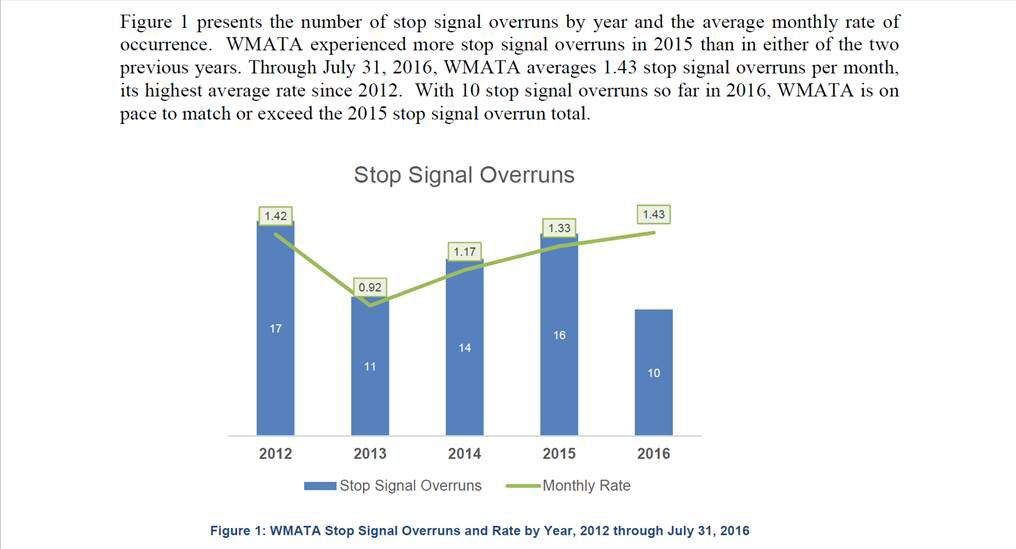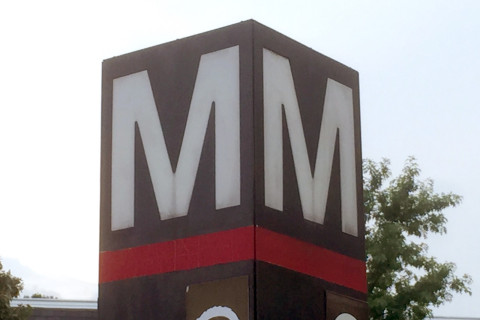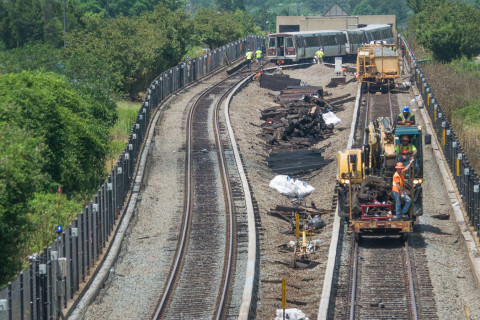WASHINGTON — Metro trains have come within seconds of colliding — and others have almost run over workers on the tracks — after running past red signals. The incidents have led to a long-awaited Federal Transit Administration report and safety order issued Monday afternoon that directs Metro to make 11 changes to make riders and workers safer.
There are now an average of 1.43 red signal violations per month in the system, with an overall total of 68 confirmed violations since 2012. Four times since 2012, trains have come within 500 feet of each other. The system is on pace for more confirmed red signal variations this year than last, but the cumulative average since 2012 has remained relatively flat over that period.
While some of the violations are in rail yards, last month, a series of four violations included the July 5 incident in which a train operator who was apparently in a rush to reach his break had a “childish” dispute before zipping out of the Glenmont station. He nearly hit two workers on the tracks, and only stopped before hitting another train head-on because he heard them yelling. His radios were turned down or off.
In other incidents, including a near-collision in February, miscommunication has been identified as the major problem.
Radio communication and a lack of discipline in the Rail Operations Control Center have been identified as a serious issue in other instances, including the deadly smoke incident near L’Enfant Plaza last year.
In other cases, the new FTA report finds radio communication issues are tied to “dead spots” in the Metro system where radios do not work or other areas where there is major distortion or feedback.
“Many WMATA employees throughout the agency ranked poor radio performance as their top safety concern,” the report stated. Metro has plans to make some radio improvements. “WMATA must continue to monitor how radio quality impacts the effectiveness of its communications and the safety of its operations,” FTA’s report stated.
But FTA investigators were hard pressed to identify clear trends in what was behind the violations.

“While newer operators are somewhat more likely to experience stop signal overruns than their more senior counterparts, and while more stop signal overruns occur in stations than yards, there are few clearly discernible patterns or trends regarding the occurrence of these incidents on the Metrorail system,” the report said.
Eight of the 68 incidents damaged switches and could have led to a derailment or threatened workers in a single-track work zone, in addition to the risk of collisions.
Investigators say Metro has not done enough to identify the true root causes of the violations, something new Chief Safety Officer Pat Lavin has been trying to change in all of Metro’s incident reviews.
The FTA said that Metro categorized the 68 red signal violations from January 2012 through July 2016 as the result of operator error, and that operators were disciplined and retrained. In the last year, Metro began to investigate the impact of signal location and to listen to recordings of radio communications to examine other factors involved.
Overall, the FTA hopes the new corrective actions will address three “prevalent and recurring” contributing factors:
• Lack of train operator familiarity with mainline and yard territory,
• Train operator inattention or confusion when departing from a station or terminal or moving under zero speed commands, and
• Poor or incomplete communication between the train operator and the Rail Operations Control Center (ROCC) regarding unusual train movements.
This investigation into red signal violations has been going on for months, and the FTA said Metro has already begun to make some changes.
Some of those changes included new policies to address speeding, more familiarization for train operators with where signals are, increased testing and attempts to improve communication and basic radio protocols.
Metro is also considering changes to the signal system to add redundant signals or make the signals more visible.
Metro issued an order to staff July 19 that requires proper radio protocol be followed, including repeating back commands about speed restrictions and speakers identifying themselves before communicating.
In some cases, train operators either do not know the names and locations of signals or are uncomfortable with the letter and number format Metro uses to identify them. In certain cases, the FTA suggests simply making the lettering on the signals more reflective or easier to see could help prevent problems, especially in tunnels. The FTA is also directing Metro to increase the amount of location information along the tracks.
All of the new FTA findings are in addition to other directives on red signal violations issued over the past year.
Among the six findings and 11 corrective actions in this report, Metro must increase oversight of train operators and controllers to ensure that they are following the rules, review a fatigue management system that is supposed to help keep train operators active and engaged, and consider new options to automatically stop trains before a collision.
Metro trains switched out of automatic operations after the 2009 Red Line crash. Eight-car rush-hour trains on the Red Line have returned to automatic operations in some cases. Trains today largely run in manual mode. That allows a train or maintenance vehicle that runs a red signal to continue at up to 15 mph.
The FTA estimates Metro’s work on other lines could bring automatic operation back in certain circumstances over the next few years
Last week, the FTA released another long-awaited report also tied to the spring “safety blitz” that outlined the lack of training, understaffing and other systemic safety problems tied to Metro’s track inspection and maintenance groups.
Metro has promised to increase inspections and to actually act when inspectors find issues that need to be addressed.
A track issue on the Blue, Orange and Silver lines disrupted the evening rush hour Monday as crews replaced fasteners that were found to have problems.






